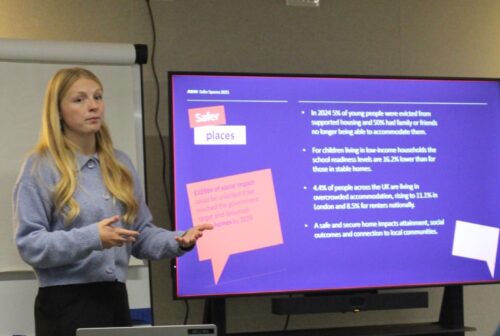Creating safer spaces through development

Ruth, our Social Impact Lead, recently spoke at an AWW event exploring ‘How can we make spaces more considerate for wellbeing? Socially, security-wise and practically?’ The event brought together planning experts, architects, policymakers and community leaders to explore how developments can create genuinely safer environments.
Rather than just building structures, the insights shared revealed how developers can create environments that transform lives and strengthen communities
The impact of a home
Ruth’s presentation focused on our research as detailed in our Impact of a Home report, which addresses the fundamental question of how to measure the value of a home beyond its market price. Through collaboration with Loop, we developed a comprehensive framework of 15 metrics to measure social impact across multiple dimensions. The report highlights that for many, a safe home remains out of reach, with children in low-income, unstable housing showing 16.2% lower school readiness levels compared to those in stable homes, while 4.4% of UK residents live in overcrowded accommodation, jumping to 11.1% in London and 8.5% for renters nationally. In 2024, 5% of young people were evicted from supported housing, with 50% losing family or friend accommodation.
Traditional approaches to community issues often fail because they ignore systemic factors. This was best exemplified by Carlie Adams Elias, Director of Practice at Safer London: when a fast-food restaurant turned off Wi-Fi to address anti-social behaviour, the problem simply moved to the local library. The real solution required collaboration between youth workers, library staff, and support services – ultimately reducing anti-social behaviour while strengthening community relationships.
For developers, this translates to a crucial principle: housing solutions must consider the broader community ecosystem rather than existing in isolation. Understanding the social infrastructure around your development is as important as the physical infrastructure.
Measuring social impact
The shift toward evidence-based social impact measurement offers developers new ways to demonstrate value. This isn’t about corporate social responsibility as an afterthought – it’s about integrating social outcomes into core business metrics from the start. Developers should keep in mind these key factors:
- Physical safety and security – measurable reductions in crime, improved emergency access, better lighting and visibility
- Community connectivity – quantifiable improvements in local engagement, access to services and social cohesion
- Long-term stability – reduced turnover, improved educational outcomes and enhanced economic opportunities for residents.
Creating positive change through development
Successful developments start with community context by investing in understanding specific community dynamics, existing social infrastructure and local support networks before breaking ground. This isn’t just consultation; it’s fundamental research that helps create homes where people can truly thrive. Building for cultural sensitivity means recognising that housing that works for one community may not serve another, requiring developments designed to meet diverse community needs and support different ways of living.
Planning for post-occupancy monitoring ensures developments continue to serve residents well over time, tracking whether the promised benefits to people’s lives are actually delivered. This ongoing commitment helps identify what works and what can be improved on for future communities. Creating safer, more supportive spaces requires ongoing partnerships between developers, residents, local authorities and support services, with these relationships built during the development process to ensure they serve the community’s evolving needs.
For developers committed to making a positive difference, social impact measurement provides a framework for understanding how their work affects real people’s lives. It demonstrates the human value of developments and creates pathways for continuous improvement. When developers prioritise measurable social outcomes alongside building homes, they create environments where residents thrive, children succeed in school, communities grow stronger and long-term wellbeing flourishes for everyone involved.
